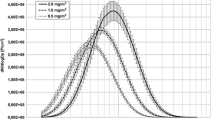Abstract
The effect of ionized air containing negatively charged ions at a concentration of 320000–350000 ions/cm3 inhaled by rats was studied. It was demonstrated that the inhalation of negative air ions for 60 min activated the secretion of goblet cells without impairing the tracheal mucosa and changing the protein profile of bronchoalveolar lavage. It was also found that the level of spontaneous production of reactive oxygen species by unfractionated blood cells increased after the action of negative air ions in both males and females. However, the intensity of their generation induced by opsonized zymosan increased only in females. Different sensitivities of the female and male blood antioxidant enzymes—superoxide dismutase and glutathione reductase—to negative air ions were observed. These results allow the effect of negative air ions on the respiratory organs and blood to be interpreted as priming and weak activation via a direct action on the mucosa of primary target respiratory organs and then on the blood.
Similar content being viewed by others
Abbreviations
- NAI:
-
negative air ions
- BAL:
-
bronchoalveolar lavage
- ROS:
-
reactive oxygen species
- SOD:
-
superoxide dismutase
- GR:
-
glutathione reductase
References
A. L. Chizhevsky, Problems in Aeroionification in the Economy (Gosplanizdat, Moscow, 1960) [in Russian].
A. L. Chizhevsky, in On the Shore of the Universe. Unexplainable Phenomenon (Mysl’, Moscow, 1995), pp. 41–73 [in Russian].
N. I. Goldstein and T. V. Arshavskaya, Z. Naturforsch, [C] 52, 396 (1997).
L. I. Gerasimova, in Lasers in the Surgery and Therapy of Thermal Burns (Meditsina, Moscow, 2000), pp. 164–174 [in Russian].
E. A. Kosenko, Yu. G. Kaminsky, I. G. Stavrovskaya, et al., FEBS Lett. 410, 309 (1997).
M. N. Kondrasheva, E. V. Grigorenko, A. V. Tikhonov, et al., IEEE Trans. Plasma Sci. 28(1), 230 (2000).
N. I. Goldstein, R. N. Goldstein, and M. N. Merzlyak, Int. J. Biometeorol. 36, 118 (1992).
N. I. Goldshtein, Biokhimiya 67(2), 194 (2002).
S. P. Grigor’ev, Doctoral Dissertation in Medical Sciences (Russian Sate Medical University, Moscow, 2004).
S. P. Grigor’ev and O. V. Aleksandrov, Ross. Med. Zh., No. 2, 14 (2003).
T. V. Sirota, V. I. Novoselov, V. G. Safonova, et al., IEEE Trans. Plasma Sci. 34(4), 1351 (2006).
S. V. Novoselov, I. V. Peshenko, V. I. Popov, et al., Cell Tissue Res. 298, 471 (1999).
L. K. Romanova and T. B. Mladkovskaya, Innovation No. 27/83 (Institute of Human Morphology, Russian Academy of Medical Sciences, Moscow, 1984).
V. G. Safronova, N. K. Matveeva, N. V. Avkhacheva, et al., Byull. Eksp. Biol. Med. 136(9), 295 (2003).
T. V. Sirota, Vopr. Med. Khim. 45(3), 263 (1999).
T. V. Sirota, N. V. Lange, N. I. Kosjakova, et al., Curr. Topics Biophys. 24(2), 185 (2000).
S. Hosoda and W. Nakamura, Biochim. Biophys. Acta 222, 53 (1970).
Brief Chemical Encyclopedia (Sov. Entsiklopediya, Moscow, 1961), Vol. 1, p. 838 [in Russian].
P. A. Korzhuev, Hemoglobin (Nauka, Moscow, 1964) [in Russian].
Author information
Authors and Affiliations
Corresponding author
Additional information
Original Russian Text © T.V. Sirota, V.G. Safronova, A.G. Amelina, V.N. Mal’tseva, N.V. Avkhacheva, A.D. Sofin, V.A. Yanin, E.K. Mubarakshina, L.K. Romanova, V.I. Novoselov, 2008, published in Biofizika, 2008, Vol. 53, No. 5, pp. 886–893.
Rights and permissions
About this article
Cite this article
Sirota, T.V., Safronova, V.G., Amelina, A.G. et al. The effect of negative air ions on the respiratory organs and blood. BIOPHYSICS 53, 457–462 (2008). https://doi.org/10.1134/S0006350908050242
Received:
Published:
Issue Date:
DOI: https://doi.org/10.1134/S0006350908050242



